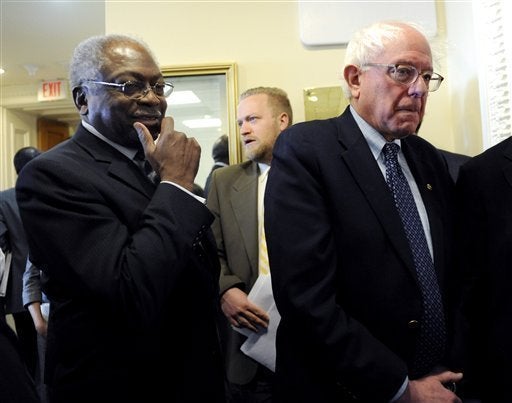
The Federal Reserve System has doled out more than $2 trillion in an effort to stave off the financial crisis, pouring money into "hundreds and hundreds" of banks, according to Federal Reserve chief Ben Bernanke.
Which banks? On what terms? At what rates? Don't ask the Fed.
Sen. Bernie Sanders, an independent from Vermont, intends to put the Senate on record opposed to such Fed secrecy.
"The contrast is pretty clear," Sanders tells the Huffington Post, "if you want to know who received the money under TARP, go to the website, it's there. If you want to know who received the money from the Fed, it ain't there."
Sanders opposed the initial TARP funds, but says that as long as money's being spent, taxpayers ought to know where it's going. This week, he will introduce a Sense of the Senate resolution calling on the Fed to release information to the public regarding what it's doing with its money.
"The argument is that it would hurt these companies if the public was made aware that they need the money. I just don't accept that. I just don't accept that," says Sanders.
Sanders attempted to introduce a similar amendment during a budget hearing, but parliamentary rules forced him to scale it down. So he's bringing it to the Senate floor.
"I think it would have won, to be honest, in the budget committee," he says. "I think most senators, most Americans, find it hard to believe that $2.2 trillion could be put at risk and you don't know who's getting it. It's pretty hard to defend."
Sanders says he will follow with binding legislation, but wants to put senators on record first. "It puts the Senate on record -- and I think there is growing support from both the left and the right on this -- that we need transparency at the fed, which operates with more secrecy than any other institution," he says.
The full text of Sanders' resolution:
SEC. __. SENSE OF THE SENATE TO INCREASE TRANSPARENCY AT THE FEDERAL RESERVE.
(a) Findings.--The Senate finds that--
(1) On January 28, 2009, Doug Elmendorf, the Director of the Congressional Budget Office, provided testimony to the Senate Budget Committee, that the Federal Reserve has committed nearly $2.3 trillion - more than three times the cost of the Troubled Asset Relief Program - to programs it created to deal with the financial crisis - with the potential for this taxpayer assistance to grow to at least $4.5 trillion.
(2) On March 7, 2009, Bloomberg News reported that "Government loans, spending or guarantees to rescue the country's financial system total more than $11.7 trillion since the international credit crisis began in August 2007."
(3) Unlike the Troubled Asset Relief Program, the American public does not know the names of the recipients of more than $2.2 trillion in taxpayer assistance provided by the Federal Reserve since the beginning of the current U.S. financial crisis.
(4) While Congress has spent numerous hours of debate on the merits of federal investments totaling less than $1 billion, not one significant debate has been held on the floor of the Senate or the House of Representatives in Congress on whether the Federal Reserve should be exposing American taxpayers to more than $2.2 trillion in risk.
(5) On March 3, 2009, Federal Reserve Chairman Ben Bernanke, told the Senate Budget Committee that since the start of the financial crisis, the Federal Reserve has provided assistance to "hundreds and hundreds of banks," but would not name the banks, how much assistance they have received, what they are doing with this taxpayer assistance, or what the specific terms of this assistance were.
(6) The American people have a right to know who the Fed is lending over $2.2 trillion taxpayer dollars to, how much they are receiving and what the Fed is asking in return for this money.
(7) Since the creation of the Federal Reserve in 1913, there has not been a single, comprehensive independent audit of the Federal Reserve System or the Federal Reserve Banks.
(8) During the worst financial crisis in our nation's history since the Great Depression - a crisis which has led to the largest taxpayer bail-out ever -- the Federal Reserve has a responsibility to the American people to explain what the Federal Reserve is doing with their hard-earned taxpayer dollars.
(b) Sense of the Senate.--It is the sense of the Senate that--
(1) the Comptroller General of the United States should be provided with the resources and authority necessary to conduct a comprehensive audit of the Board of Governors of the Federal Reserve System and the Federal reserve banks; and
(2)the Board of Governors of the Federal Reserve System (in this Act referred to as the `Board') should publish on its website, with respect to all lending and financial assistance facilities it has created to address the financial crisis since March 24, 2008, the following:
(A) the identity of each business, individual, or entity to which the Board has provided such assistance;
(B) the type of financial assistance provided to that business, individual, or entity;
(C) the value or amount of that financial assistance;
(D) the date on which the financial assistance was provided;
(E) the specific terms of any repayment expected, including the repayment time period, interest charges, collateral, limitations on executive compensation or dividends, and other material terms; and
(F) the specific rationale for providing assistance in each instance; and
(G) what that business, individual, or entity is doing with this financial assistance.
